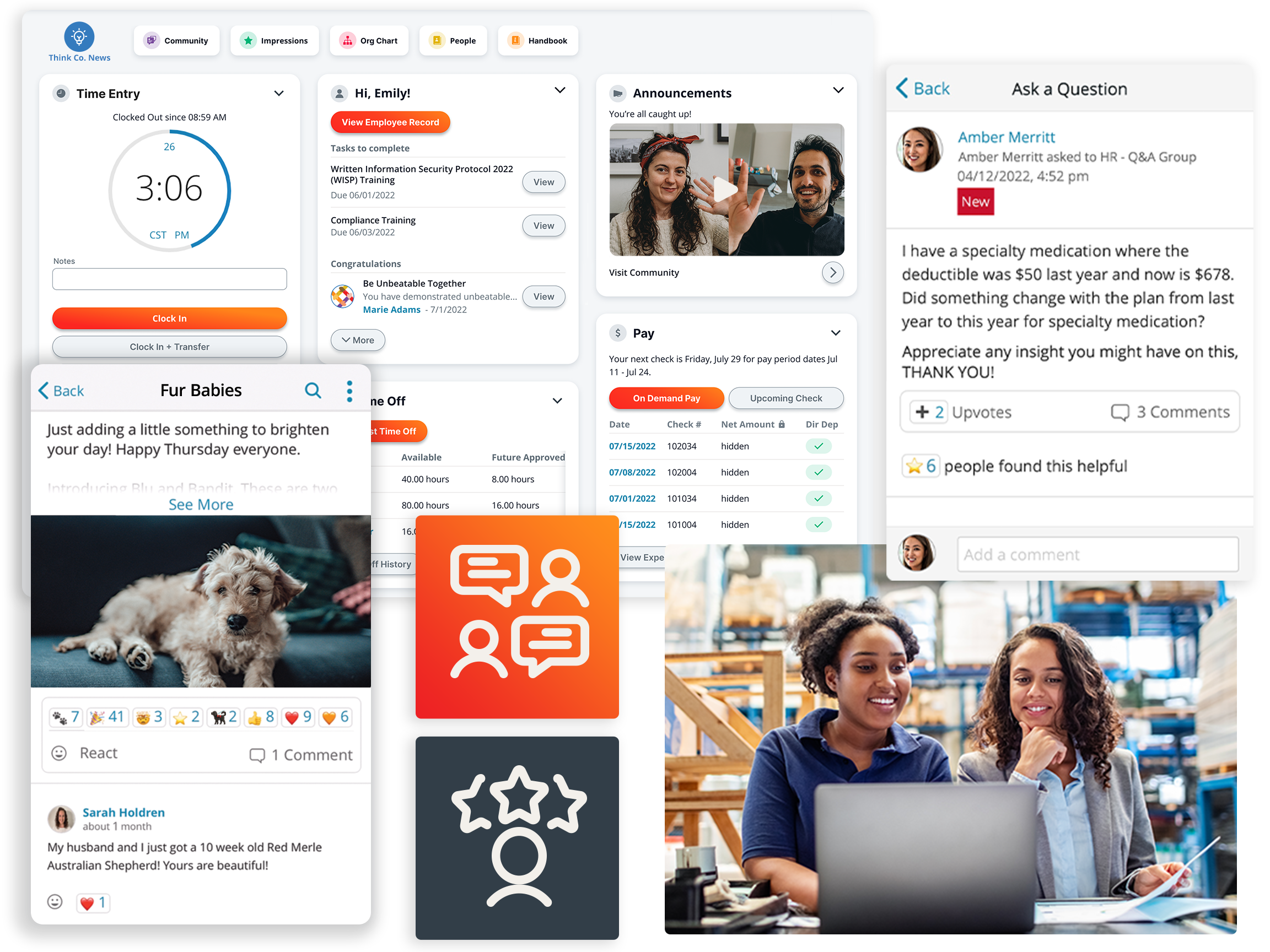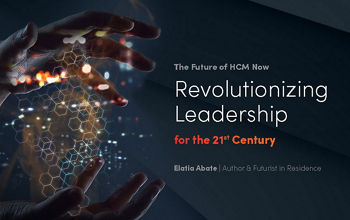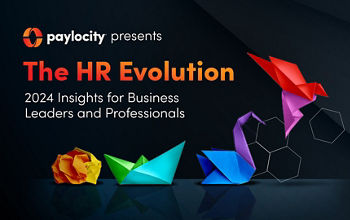resources
How to Tackle 5 HR Challenges — Now and in the Future
January 12, 2024
Two HR leaders take on everyday issues that are top of mind for 2024 and beyond.
Blog Post

In August of 2023, Elatia Abate, Paylocity’s Futurist in Residence, enthralled HR and business leaders live and virtually with her vision for the workplace of tomorrow.
Except for one attendee, who commented what others were probably thinking:
“All this future talk is great, but it’s hard to care when all my time is stuck in the day-to-day responsibilities.”
Given the complexities of work and the world today, how can HR reconcile the immediate needs of employees and the business while also laying the groundwork for innovation and ongoing success?
Good question.
We invited Elatia to sit down with Paylocity’s own CHRO, Jill Morrison, to talk about this fundamental problem and other top HR challenges that keep leaders from focusing on the future.
1. How Can HR Balance Core and Cool Tech?
Elatia freely admits it’s hard to strike the right balance between now-focused, results-producing actions and future-forward, innovative thinking.
For Jill, who oversees talent strategy for 6,000 employees and growing, that means having complete confidence in core HR functions first, like accurate payroll and benefits.
“It’s what opens up the doors to everything else.”
While technological advances are unstoppable, Jill explains, they also enable organizations to communicate better, engage, retain, and help employees develop their skills. But to take full advantage of the newest tools, HR leaders need to embrace what Elatia calls “simultaneous strategy” — the ability to focus on both now and next.
Jill and Elatia agree that the pace of change in business today requires a paradigm shift. Hear how HR can leverage technology to evolve from a world of “either/or” to one of “both/and.”
Prepare for the future with Elatia Abate’s eBook, Revolutionizing Leadership for the 21st Century.
2. How Can HR Keep Up With Compliance Changes?
Employment legislation seems to become more complex every day. Sometimes it’s easy to lose sight of why compliance exists in the first place: to support employees.
HR and business leaders always want to provide a safe, healthy work environment. Today, though, keeping up with changes in compliance — especially if you have workers in multiple states or other countries — is daunting.
“For me,” Jill says, “it comes down to what and how.”
In her experience, HR leaders are often focused on what’s going on within their organization, so they need a reliable source who can keep tabs on what’s going on everywhere else. That may be an internal team or external resources, or some combination.
But the real challenge in managing compliance is the next step: Knowing how to apply that new information, whether that means updating a tax code, adjusting PTO accruals, or sharing new OSHA training.
Not surprisingly, Jill turns to technology for help. The key, she says, is having tools within your HCM system that make compliance easier for everyone.
Check out this video clip as Jill and Elatia discuss the “healthy tension” between what’s right for employees and what’s right for the business.
Learn More: HR Compliance 101: Fundamentals for HR Professionals
3. How Can HR Improve Internal Communications?
Modern workforces are distributed around the world and working in different ways. Often this means employees use a variety of devices and software to communicate, which can make it hard to keep everyone informed and connected with your organization. In addition, employers today compete for their employees’ attention with a barrage of disruptions outside of work.
These distractions have taken the need for quality employee communication to a new level.
“For us, we think about having a very thoughtful, very purposeful communications strategy across the company,” Jill says.
Not only do workers expect communication to be easy and accessible, as it is in their everyday lives. They also want to be part of a community. Elatia sees this as a huge opportunity for HR leaders.
“It’s about making and creating a reason for employees to engage.”
She suggests today’s workforce is motivated less by past notions of “networking” and more by curiosity and a deep desire to contribute value. Leaders can leverage HCM platforms with integrated communication and collaboration tools to help employees discover, grow, and celebrate their impact.
Listen in as Elatia and Jill discuss essential tools and practical tactics for building a more connected culture.
4. How Can HR Empower Managers for Better Engagement?
Jill sees HR’s role becoming more multi-layered when it comes to engaging employees.
“Understanding the strengths, the opportunities of the business — that’s always something HR leaders are going to be really focused on,” she says. “But what we actually know is that the biggest impact on an individual’s engagement is their relationship with their team and their relationship with their direct manager.”
Coaching managers in engagement is increasingly necessary, especially those who supervise a dispersed team. With advanced employee survey technology, HR can help managers better understand employee feedback and translate it into best practices.
By empowering managers with actionable data and the tools to follow through, HR shares the responsibility of engagement, which enables scale.
As an example, Jill describes how Paylocity’s Employee Voice helps HR create an agile feedback loop so that organizations can make incremental changes quickly and measure success as they go.
“It’s the small things that make the biggest impact,” she says.
Join the conversation as Jill and Elatia talk about ways to strengthen the employee-manager relationship.
5. How Can HR Create a Culture of Recognition?
Organizations have a lot of different employee recognition tools at their disposal today. One challenge is bringing these tools together in a cohesive program that increases engagement and builds a stronger company culture.
To Jill, this means “meeting employees where they are” with personalized recognition. She shares a recent example of an employee appreciation initiative at Paylocity that generated more than 20,000 individual responses over one week.
Elatia sees customized recognition becoming even more important as future workforces span four and five generations.
“The ability to engage very specifically with people and lift them up in ways that are going to be particularly meaningful to them,” she says. “What an exciting time and opportunity!”
Elatia also points out that recognition is a way to spotlight desired employee behaviors and encourage others to emulate them. Aligning recognition with your company values builds employer authenticity and integrity, which will be critical moving forward.
“It’s such a strategic advantage for organizations for keeping the best talent.”
Watch the video for more ideas from Elatia and Jill to weave recognition throughout your organization and the employee experience.
Now and Next: The Future of HCM
It’s hard to look forward if you’re also looking over your shoulder. Yet that’s exactly what today’s HR leaders are being asked to do.
Peace of mind comes with confidence that the day-to-day operations are running smoothly, which in turn gives HR the flexibility to focus on employee engagement and long-term business outcomes.
To find balance between now and next, HR teams — as well as employees, managers, and leaders — need to be equipped with tools that “meet them where they are.”
And where they want to go.

Unlock Your Company's Potential with Connected HR
From automating processes to driving culture, you need an HR system as connected to your company as you are. Discover how you can break down communication barriers, simplify processes, and drive a more connected workplace with an all-in-one platform.


